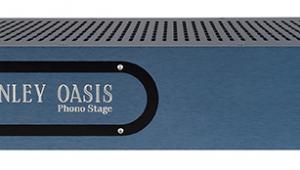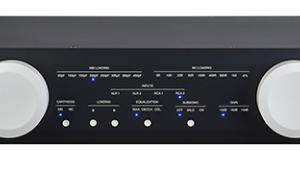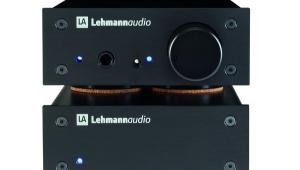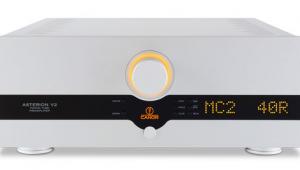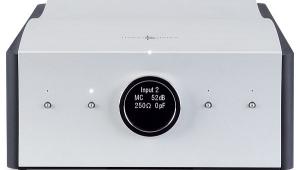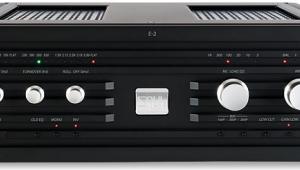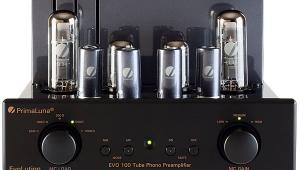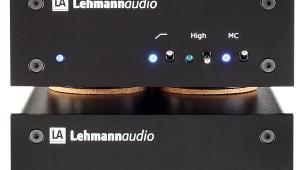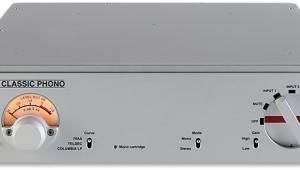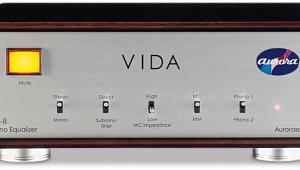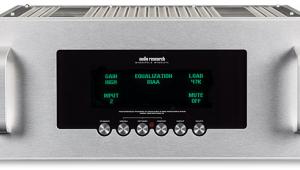Air Tight Ath 2a, Ate 2005 (£2695/£5495)

With at least three turntables active in my system at any time, I’ve learned to appreciate options. All of my preferred phono amplifiers accept at least two decks and can cope with both MM and MC cartridges of varying output levels. And yet a part of me has always admired step-up transformers for their freedom from the mains, while another part of me respects phono stages with hardly any options at all – minimalism having its own virtues.
Air Tight, which has charmed me with its gorgeously-appointed preamps, power amps and integrateds for a quarter-century, is so analogue-oriented that the company offers five phono stages, including a two chassis Reference model with the same price tag as a loaded Nissan Juke, a hotrodded version of the transformer under review here and an outboard phono stage for one of the line-level preamps. The two we’re looking at are a classic, passive MC step-up transformer and a valve-driven phono equaliser.
TRIPLE WHAMMY
Common to both, besides lovely styling and delicious build quality, are the facility to accept three turntables, which may be a deal-maker for some of you with a selection of decks, or multi-arm turntables like the old Micro-Seikis. All of the sockets on the backs of the two models are high-grade, gold-plated phonos, each unit having three pairs of inputs and one set of outputs, plus an earthing post. The ATE-2005 accepts its AC through an IEC 3-pin socket.
Air Tight always fits buttons and rotary selectors that are a delight to operate. The ATE-2005 phono equaliser carries two small rotaries to choose between an MC input or either of two MM inputs, and one to switch on the cartridge demagnetiser, with a button for power on. The ATH-2A transformer uses two large rotaries for selecting Input 1, 2 or 3, and MC cartridge settings of 2ohm or 40ohm, or Bypass should you use an MM cartridge. Note: the ATH-2A, being a step-up, must be used into an MM input of 47kohm.
As it only needs to house transformers, the ATH-2A is dinky, at 240x70x180mm (whd). The ATE-2005, on the other hand, contains a low-noise, high-stability equaliser stage featuring a trio of selected 12AX7/ECC83 valves, four independent circuits to prevent interference for lownoise operation, the degauss function to remove cartridge magnetism, and hard-wiring throughout. Its chassis is still compact, however, at 370x100x280mm (whd). Gain is specified as 53dB in MC mode, or 30dB when MM is selected.
MAGNETIC ATTRACTION
Regarding the demagnetising facility, I’m not in the mood to debate its worth after its presence in the audio community for at least a couple of decades. I realise, though, that the topic is moot in some quarters. I’ve been a fan ever since Gryphon released the Black Exorcist, and have used others over the years. I find them most audibly effective if I’m digging out a cartridge that hasn’t been used for some time, but also of benefit to cartridges that have experienced heavy use. Its presence in the ATE-2005 is a worthy convenience if you believe in demagnetising, but it has no bearing on a verdict about the unit’s performance.
Leaving aside the demagnetiser, one is paying for a superbly-made, great-sounding device. Ditto for the ATH-2A transformer. But neither can be described as even remotely cost-effective, and one needs to accept – if he or she is to read any further – that Air Tight devices are not mass-market constructs from the likes of a Rotel or a Denon, which can pass on the savings from quantity production.
These are hand-made jewels, and one must decide whether such artisan exclusivity has added value. After 30 years of writing about high-end gear and listening to complaints, I’ll simply reiterate that only you can decide if a product is worth its asking price.
A number of permutations presented themselves for assessing the two devices. For MM phono stages to feed with the ATH-2A step-up, I used the Quad II Classic Integrated and McIntosh C2200 preamp, as well as the MM inputs of the ATE-2005. The Quad also has an MC setting, so I was able to compare that to the ATE-2005’s and ATH-2A’s MC inputs.
Turntable combinations included Linn LP12 with Ekos arm and Arkiv cartridge, and the SME 30/12 with Series V 12in arm and a range of cartridges: Air Tight PC1, Transfiguration Orpheus, Shure V15-Vx, Kiseki Blue and Ortofon 2M Blue. Also used were the new Sonus faber Guarneri and Wilson Audio Sophia 3 speakers, and Quad II-eighty power amplifiers, with all wiring coming from Yter. No accessories were used between cartridge and preamp.
FAMILY LIKENESS
Keen listeners will detect immediately a family resemblance between the ATH-2A and ATE-2005, especially if one has filtered out the influence of a third MM stage by feeding the ATH-2A into one of the ATE-2005’s MM inputs. One will never mistake the former for the latter, because the differences are huge, but underneath is a characteristic sound that will ring bells with Air Tight devotees.
Irrespective of cartridge, deck or tonearm, the Air Tight sound is defined by a delicacy and silkiness that even benefits music of some power, however elephantine. From the J Geils Band’s 1978 classic Sanctuary were pounding footstomps, majestic organ fi lls, Geils’ wailing guitar breaks and Magic Dick’s limitless harp ascendancies, each preserved in such a way that the listener faced a fi ne mesh of powerful notes that, frankly, should have competed with each other rather than coalesced.
But there’s a big ‘however’: the ATE-2005 showed far wider dynamic contrasts, as impressive as the cartridges’ rise times and tracking abilities would allow, which bettered the transformer on all but the highest-output MCs. MM was almost too close to call, which means, simply, that the ATH-2A, when bypassed, is audibly ‘invisible’. In fact, the MM side of the ATE-2005 was easily superior to the onboard stages I tried, especially in dynamics and bass solidity, such that one might even posit that it’s worth acquiring even if your preamp has an MM section.
Thus, it’s clearly the MC performance that serves as the raison d’être for either unit. What kept the ATH-2A in the running, even though it could not match the bass kick of the valve-driven ATE-2005 on the Geils recording, was a whispery fi nesse which benefi ted LPs such as the Nat ‘King’ Cole remasters from Acoustic Sounds. Vocal textures were about as real as they come, especially when using the Air Tight PC-1 cartridge with the transformer set to 2ohms, while massed strings were less edgy or potentially aggressive than with the ATE-2005.
Yet there’s a big ‘but’: the ATH-2A, which I’ve grown to adore, simply lacks the scale of the ATE-2005, particularly on stage depth. It’s a manifestation that will only be evident if you’re using a system optimised for ultra-wide-and-deep soundstaging, possibly at the cost of other elements, such as deep bass. (But that’s why I love Sophia 3s, which balance the two.) Through the ATH-2A it was easily possibly to hear layers of sound on the vinyl 12in single of the Human League’s ‘Don’t You Want Me’, however artifi cial that recording may be.
Switch over to the ATE-2005, though, and the layers separate like a baklava under the fork of a famished gourmand. If you never heard the ATE-2005, you’d still fall in love with the ATH-2A – ignorance is, after all, bliss. But the way the sound opens up, despite a superfine increase in the noise-fl oor between the two, is preferable for those who have systems capable of creating a vast image.
Turning to one of rock music’s most tasteful LPs of all time – the Left Banke’s Walk Away Renée, recently reissued on Sundazed, and a paradigm of ‘Baroque pop’ – the two units personifi ed what I adore about every Air Tight component I’ve been lucky enough to try. This was a group for which the term ‘gossamer’ might have been invented, and even live they managed to impart the elegance normally associated with string quartets in a Viennese parlour. Any LP that opened with cello, oboe, violin and piano, backed by a rock drummer, was bound to open ears. Both Air Tights caressed the material, the atmosphere they created explaining the first part of the name, the composure defining the second part.
A CASE FOR OWNING BOTH
After all that, why would one want both? While either will ensure that you have enough inputs to keep multiple turntables wired into your system at all times, some fanatics might want even more. Feed the ATH-2A into one of the ATE-2005’s MM inputs, or the ATE-2005 into any of the ATH-2A’s inputs, and use the latter’s Bypass mode, and you have inputs for five turntables or arm/ cartridge combinations.
More seriously, though, the sound of the transformer differs sufficiently from the fully-active preamp, so having both enables ultra-hardcore vinyl users to tailor such considerations as quietness and dynamics to their cartridges. Seasoned users know, for example, that the dynamic capabilities, noise fl oors and impact vary wildly between, for example, Londons, Grados, low- and high-output MCs, ‘normal’ MMs, etc.As one who veers between aged Ortofon and Denon MCs, modern greats like the Lyras and Transfigurations, and the Londons, a wide range of options makes life much easier. That’s why I’ve always appreciated minimalist phono amps or step-ups, but prefer to live with units like AudioValve’s Sunilda, the various Audio Research phono amps and ultra-flexible units from EAR-Yoshino, EMT and Manley, which accommodate as wide a range of devices as you could muster.
VERDICT
Though the two Air Tights aren’t exactly generous with impedance or capacitance loadings, the two together prove flexible enough for most needs, while either’s basic settings will suit most cartridges besides freakish designs with outré specs. For most of us, finances will determine which to buy. But if I could only have one, I’d opt for the punchier ATE-2005. Then again, that ATH-2A is sooo quiet…
Originally published in the October 2011 edition


